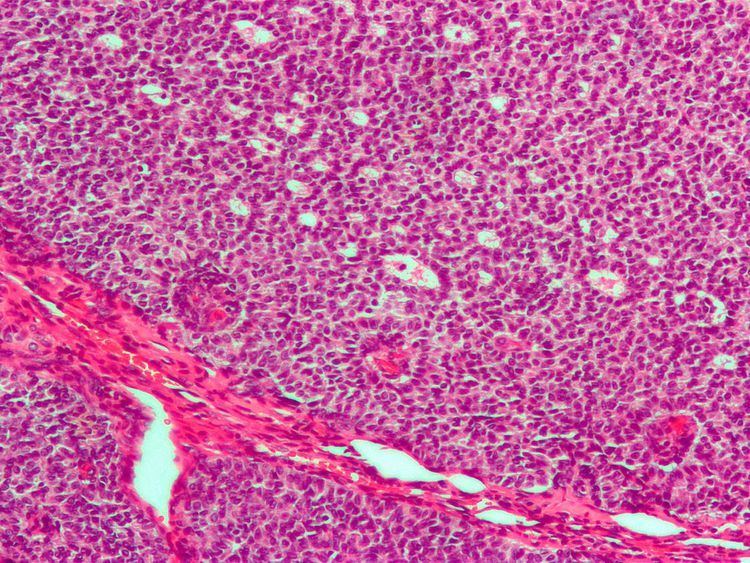Specialty oncology MeSH D018312 | ICD-10 C56.9, C62 | |
 | ||
ICD-O 8590/1, 8600, 8620, 8631 | ||
Sex cord–gonadal stromal tumour (or sex cord–stromal tumour) is a group of tumors derived from the stromal component of the ovary and testis, which comprises the granulosa, thecal cells and fibrocytes. In contrast, the epithelial cells originate from the outer epithelial lining surrounding the gonad while the germ cell tumors arise from the precursor cells of the gametes, hence the name germ cell. In humans, this group accounts for 8% of ovarian cancers and under 5% of testicular cancers. Their diagnosis is histological: only a biopsy of the tumour can make an exact diagnosis. They are often suspected of being malignant prior to operation, being solid ovarian tumours that tend to occur most commonly in post menopausal women.
Contents
This group of tumours is significantly less common than testicular germ cell tumours in men, and slightly less common than ovarian germ cell tumours in women (see Ovarian cancer).
Types
These tumours are of the following types, characterized by their abnormal production of otherwise apparently normal cells or tissues.
Although each of the cell and tissue types normally occurs in just one sex (male or female), within a tumour they can occur in the opposite sex. Consequently, depending on the specific histology produced, these tumours can cause virilization in women and feminization in men.
Tumour types in order of prevalence
Diagnosis
Definitive diagnosis of these tumours is based on the histology of tissue obtained in a biopsy or surgical resection. In a retrospective study of 72 cases in children and adolescents, the histology was important to prognosis.
A number of molecules have been proposed as markers for this group of tumours. CD56 may be useful for distinguishing sex cord–stromal tumours from some other types of tumours, although it does not distinguish them from neuroendocrine tumours. Calretinin has also been suggested as a marker. For diagnosis of granulosa cell tumour, inhibin is under investigation.
On magnetic resonance imaging, a fibroma may produce one of several imaging features that might be used in the future to identify this rare tumour prior to surgery.
Prognosis
A retrospective study of 83 women with sex cord–stromal tumours (73 with granulosa cell tumour and 10 with Sertoli-Leydig cell tumour), all diagnosed between 1975 and 2003, reported that survival was higher with age under 50, smaller tumour size, and absence of residual disease. The study found no effect of chemotherapy. A retrospective study of 67 children and adolescents reported some benefit of cisplatin-based chemotherapy.
Research
A prospective study of ovarian sex cord–stromal tumours in children and adolescents began enrolling participants in 2005.
